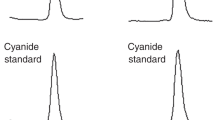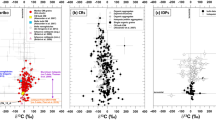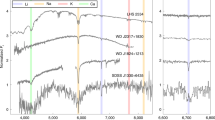Abstract
BORON is remarkable in that its compounds are common and inexpensive although the element occurs quite low on the cosmic abundance scale, alongside lithium and beryllium. The cosmic scarcity of these three light elements is related to the ease with which their nuclei are disintegrated during nucleogenesis, whereas the terrestrial familiarity of borates can be traced to the mobility of boric acid in water, steam and “volcanic emanations”.
This is a preview of subscription content, access via your institution
Access options
Subscribe to this journal
Receive 51 print issues and online access
$199.00 per year
only $3.90 per issue
Buy this article
- Purchase on Springer Link
- Instant access to full article PDF
Prices may be subject to local taxes which are calculated during checkout
Similar content being viewed by others
References
Shima, M., Geochim. Cosmochim. Acta, 27, 911 (1963).
Wasson, J. T., J. Geophys. Res., 70, 4443 (1965).
Harder, H., Nachr. Akad. Wiss. Göttingen, math-phys. Kl., 1, 1 (1961).
Ringwood, A. E., Rev. Geophys., 4, 113 (1966).
Taylor, S. R., Geochim. Cosmochim. Acta, 28, 1273 (1964).
DuFresne, E. R., and Anders, E., Geochim. Cosmochim. Acta, 26, 1085 (1962).
Nagy, B., and Claus, G., in Advances in Organic Geochemistry (edit. by Colombo, U., and Hobson, G. D.) (Pergamon, 1964).
Nagy, B., Meinschein, W. G., and Hennessy, D. J., Ann. NY Acad. Sci., 108, 534 (1963).
Mueller, G., Shaw, R. A., and Ogawa, T., Nature, 206, 23 (1965).
Kerridge, J. F., Nature, 217, 729 (1968).
Mueller, G., Nature, 218, 1239 (1968).
Mueller, G., in Advances in Organic Geochemistry (edit. by Colombo, U., and Hobson, G. D.) (Pergamon, 1964).
Mueller, G., Nature, 211, 1134 (1966).
Bernas, R., and Gradsztajn, E., Ann. Phys., 44, 426 (1967).
Reed, G. W., and Jovanovic, S., J. Geophys. Res., 72, 2219 (1967).
Ehmann, W. D., and Lovering, J. F., Geochim. Cosmochim. Acta, 31, 357 (1967).
Barnes, H. L., Geochemistry of Hydrothermal Ore Deposits (Holt, New York, 1967).
Young, B. R., Harrison, R. K., Sergeant, G. A., and Stevenson, I. P., Proc. Yorkshire Geol. Soc., 36, 417 (1968).
Sylvester-Bradley, P. C., and King, R. J., Nature, 198, 728 (1963).
Nooner, D. W., and Oró, J., Geochim. Cosmochim. Acta, 31, 1359 (1967).
Hayes, J. M., Geochim. Cosmochim. Acta, 31, 1395 (1967).
Author information
Authors and Affiliations
Rights and permissions
About this article
Cite this article
MILLS, A. Boron in Carbonaceous Chondrites. Nature 220, 1113–1114 (1968). https://doi.org/10.1038/2201113a0
Received:
Revised:
Issue Date:
DOI: https://doi.org/10.1038/2201113a0
This article is cited by
-
Cosmic Abundance of Boron
Nature (1973)
Comments
By submitting a comment you agree to abide by our Terms and Community Guidelines. If you find something abusive or that does not comply with our terms or guidelines please flag it as inappropriate.



